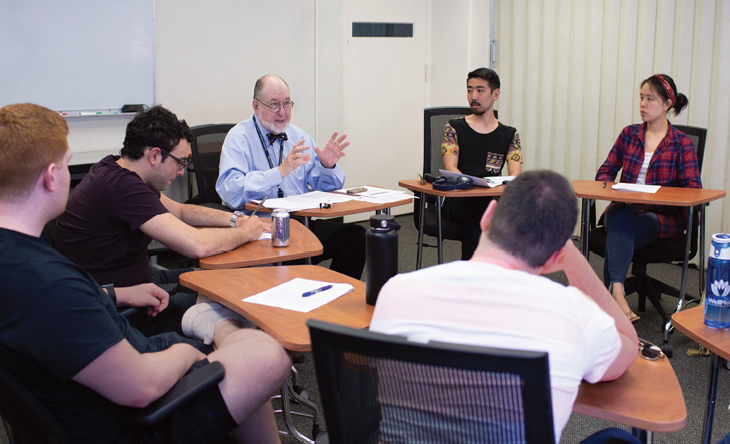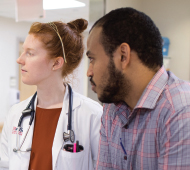A 10-month-old girl sits in a pediatrician’s office with her grandmother. Two days ago she was in the hospital because a piece of a candy bar was lodged in the airway leading to her right lung. Doctors removed it successfully and she’s breathing comfortably now, but her grandmother, who speaks limited English, has some questions.
She doesn’t understand the handout about choking hazards that they were given when they left the hospital or why they received it. She also wonders if the mold in their apartment might be contributing to the baby’s wheezing and to her other granddaughter’s asthma.
As the baby’s physician, what do you focus on during this visit? The choking risks, certainly. But what about addressing what you suspect is food insecurity? And what about the mold problem?
 ABOVE, Stephen Baum, M.D., distinguished professor of microbiology & immunology, leads a workshop on clinical reasoning. TOP, clockwise from left: Third-year medical students Xavier Quezada, left, and Marouf Hossain use a ventilation device on an adult mannequin as part of basic life-support training; Eden Gelman practices on a baby model; and a student tries out lifesaving compression techniques on an adult model.
ABOVE, Stephen Baum, M.D., distinguished professor of microbiology & immunology, leads a workshop on clinical reasoning. TOP, clockwise from left: Third-year medical students Xavier Quezada, left, and Marouf Hossain use a ventilation device on an adult mannequin as part of basic life-support training; Eden Gelman practices on a baby model; and a student tries out lifesaving compression techniques on an adult model.
Cases like the real-life one above happen regularly in medicine. Third-year Einstein medical students used it as an opportunity last summer to learn about what they might face as they began their clerkships at various clinics and hospitals in the Bronx. “We want students to start thinking about all the aspects that contribute to the overall picture of their patients’ health and what they can do to help,” says Todd Cassese, M.D., assistant dean for clinical sciences at Einstein.
We want students to start thinking about all the aspects that contribute to the overall picture of their patients’ health and what they can do to help.
— Dr. Todd Cassese

The Transition to Clerkship week began with a disease-mapping exercise. Students were presented with a fictional patient who had acute rhinosinusitis, a common inflammatory condition of the upper airways that affects nearly 40 million Americans every year.
Third-year students were given key clinical features of the condition, such as congestion, loss of sense of smell, and nasal drainage; then, working in small groups, they mapped those features to their possible causes—for example, a viral infection, an allergic reaction, or nasal polyps. Using those maps, the students were asked to list four medications that could potentially be effective in treating the root causes of rhinosinusitis and not just its symptoms.
“This session was meant to help students better understand how basic-science principles are linked to clinical reasoning,” Dr. Cassese says.
Another exercise focused on the hypothesis-driven physical exam, in which students practiced physical examination maneuvers on their peers in the Clinical Skills Center in the Van Etten Building. As a leader of one of the small-group sessions, Alan Engler, M.D., a clinical assistant professor in the department of surgery, presented a scenario to the third-years: “I’m having trouble breathing. What should you do? Examine my abdomen? My neck? What questions should you ask me?”
Students took part in basic life-support training, also in the Clinical Skills Center, practicing effective compression techniques using different ventilation devices on adult and baby mannequins. Other sessions included work-life balance (see “A Stressful Learning Environment”), best practices regarding electronic health records, note writing in different specialties, clinical informatics at the bedside, medical interpreters, the student’s role on the interdisciplinary healthcare team, developing a professional identity, and career planning.
Now many weeks into his clerkship, Mr. Iqbal reports that “the days are long but the weeks are short. Medicine is one of the hardest careers as far as hours per week, but it’s one of the most gratifying. So far it has been an amazing experience. Nothing beats learning on the job.”